|
Nov 22, 1887
|
Born in Edinburgh, Scotland to
William and Magdalene Campbell (nee Steven) Pattison
|
|
Apr 16, 1910
|
Embarked the SS Columbia in
Glasgow, Scotland

|
|
Apr 24, 1910
|
Disembarked in New York City,
New York, USA and proceeded to Toronto, Ontario
|
|
Apr 12, 1916
|
Signed the Officer’s
Declaration to volunteer in the 155th Battalion CEF in Marlbank,
Ontario
Ø Rank on enlistment
Lieutenant
Ø Next of kin given
as Magdalene Campbell Pattison, mother, 1989 Yonge St., Toronto, Ontario
Ø Previous occupation
given as Traveler for the John MacDonald Dry Goods Company
Ø Previous military
experience given as 15th Regiment, Canadian Militia and 3 years in
the Royal Scots in Edinburgh, Scotland
Ø Religion given as
Presbyterian
The battalion trained in the
Kingston, Ontario area
|
|
Oct 17, 1916
|
Embarked the SS Northland in
Halifax, Nova Scotia
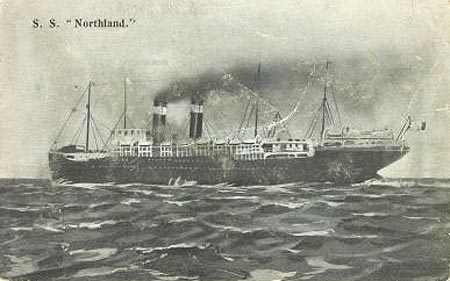
|
|
Oct 28, 1916
|
Disembarked in Liverpool,
England and the battalion proceeded to Bramshott
|
|
Dec 8, 1916
|
Transferred to the 154th
Battalion
|
|
Jan 11, 1917
|
Admitted to the Shorncliffe
Military Hospital with a diagnosis that reads Lumbago
|
|
Jan 26, 1917
|
Discharged to duty from
hospital
|
|
Jan 31, 1917
|
Transferred to the newly
formed 6th Reserve Battalion in East Sandling. Shortly after the formation of the
battalion it was moved to Seaford to continue training reinforcements for the
front
|
|
Feb 15, 1917
|
Granted sick leave
|
|
Feb 27, 1917
|
Medical board declared him fit
for general service
|
|
Feb 28, 1917
|
Reported to the 6th
Reserve Battalion for duty
|
|
Apr 24, 1917
|
Attached to the EORD (Eastern
Ontario Regimental Depot)
|
|
May 22, 1917
|
Attached to the Canadian
Discharge Depot in Buxton for Conducting Duty
|
|
Jun 1, 1917
|
After being found unfit for
General Service he was posted to the EORD
|
|
Jun 19, 1917
|
Transferred to the 6th
Reserve Battalion
|
|
Jun 20, 1917
|
Transferred back to the 6th
Reserve Battalion but remained attached to the EORD
|
|
Oct 5, 1917
|
Transferred to the 21st
Battalion
|
|
Oct 6, 1917
|
Arrived at the No. 2 CIBD
(Canadian Infantry Base Depot) in Etaples, France as part of a draft of 36
reinforcements from England and TOS (Taken On Strength) the 21st
Battalion
|
|
Nov 20, 1917
|
After leaving the base depot,
Lieutenant Pattison joined the 21st Battalion in Camblain L’Abbe,
France and was posted to “A” Company as a Section Commander
|
|
Dec 8, 1917
|
Attached to the 182nd
Company, Royal Engineers for duty
|
|
Dec 31, 1917
|
Even though he was attached to
engineers, he joined his company at the 21st Battalion for the New
Year’s Eve party
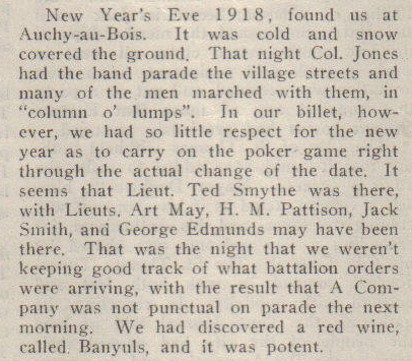
|
|
Jan 23, 1918
|
Granted 14 days leave
|
|
Jan 31, 1918
|
Ceased to be attached to the
Royal Engineers
|
|
Feb 7, 1918
|
Rejoined the battalion from
leave
|
|
Feb 22, 1918
|
Proceeded on course of
instruction
|
|
Mar 12, 1918
|
Admitted to the No. 58 CCS
(Casualty Clearing Station) with a diagnosis that reads Trench Fever
|
|
Mar 15, 1918
|
Transferred via the No. 5 AT
(Ambulance Train) and admitted to the No. 8 Canadian Red Cross, Duchess of
Westminster Hospital in Le Touquet
|
|
Mar 26, 1918
|
Invalided to England aboard
the Hospital Ship Pieter de Coninck
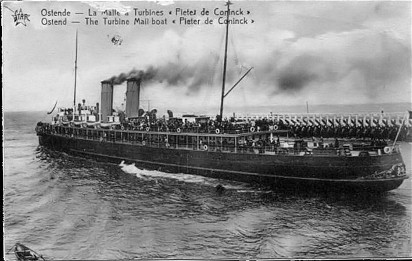
On arrival in England he was
admitted to the 2nd Western General Hospital (Worsley Hall) in
Manchester
Posted to the EORD for pay purposes
while in hospital
|
|
Apr 26, 1918
|
Transferred to the Canadian
Officer’s Convalescent Hospital in Matlock, Bath
|
|
May 13, 1918
|
Attached to the Officer’s
Casualty Company and employed with the CTS (Canadian Training School)
Canadian Engineers, Bexhill on light duties
|
|
May 21, 1918
|
Discharged from hospital care
|
|
Jul 11, 1918
|
Ceased to be attached to the
training school and attached to the 6th Reserve Battalion in
Seaford
|
|
Aug 4, 1918
|
Attached to the 3rd
CCD (Canadian Convalescent Depot) in Seaford
|
|
Sep 6, 1918
|
Discharged from the
convalescent depot and posted to the 6th Reserve Battalion in
Seaford
|
|
Sep 19, 1918
|
Transferred to the 21st
Battalion
|
|
Sep 20, 1918
|
Arrived at the No. 2 CIBD
(Canadian Infantry Base Depot) in Etaples, France and TOS the 21st
Battalion
|
|
Sep 23, 1918
|
After leaving the base depot,
Lieutenant Pattison joined the CCRC (Canadian Corps Reinforcement Camp) in
Aubin St. Vaast
|
|
Sep 27, 1918
|
After leaving the
reinforcement camp he rejoined the 21st Battalion in a bivouac
area near Riencourt, France, west of Amiens and was again posted to “A”
Company as a Section Commander
|
|
Oct 11, 1918
|
The 4th Brigade commenced
an attack on the town of Avesnes le Sec at 9.00 am and the 21st
Battalion came under heavy machine gun fire after passing through the town of
Escaudoeuvres. Fifty percent of the
Officers, NCOs and Lewis Gunners became casualties in the first 30 minutes of
the advance. Lieutenant Pattison was
one of those, being shot in the abdomen.
After receiving first aid, he was evacuated to the No. 22 CCS
(Casualty Clearing Station) for further treatment
|
|
Oct 12, 1918
|
Lieutenant Pattison died of his
wounds while at the No. 22 Casualty Clearing Station and was buried in the Bucquoy
Road British Cemetery, Ficheux, France

Note that he is buried in a double
grave with an Lieutenant from the West Yorkshire Regiment
Following the war the British War
Medal, Victory Medal, Plaque (Dead Man’s Penny), Scroll and Memorial Cross
were sent to his mother, Mrs. Magdalene Pattison, 138 Purchase St., Milford, Massachusetts,
USA
|
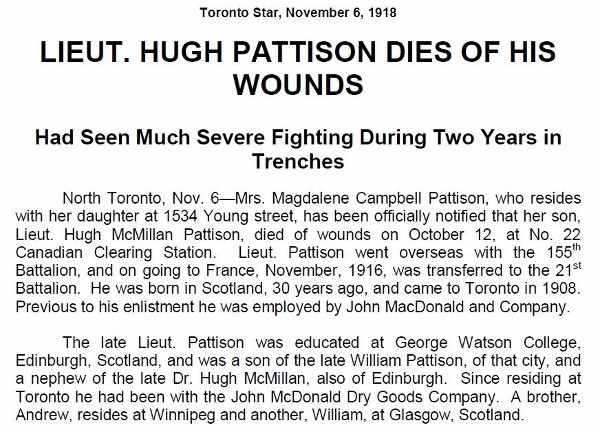
|
|
2010
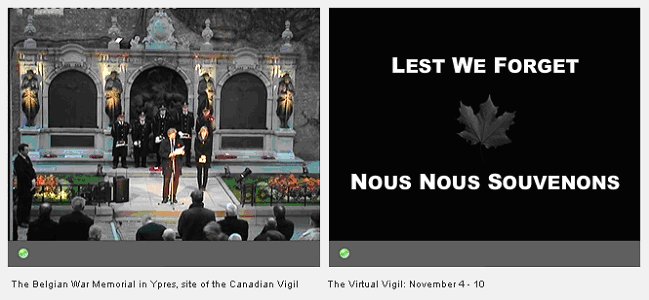
For the 7 nights leading up to
November 11, 2010, the names of all Canadian soldiers who were killed during
the Great War were projected onto the Belgian War Memorial in Ypres. At the same time, the same names were being
broadcast via the internet to schools across Belgium and Canada. The image above shows the opening
ceremonies at the Belgian War Memorial on November 4, 2010.
Below is the name of Hugh Pattison being
broadcast to the schools. Each name
appeared for 25 seconds and each night 9,700 names were shown.
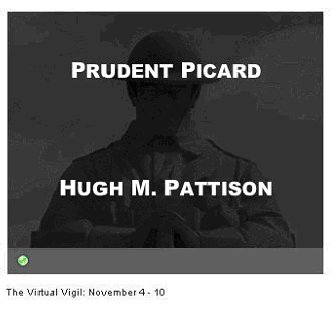
|
|